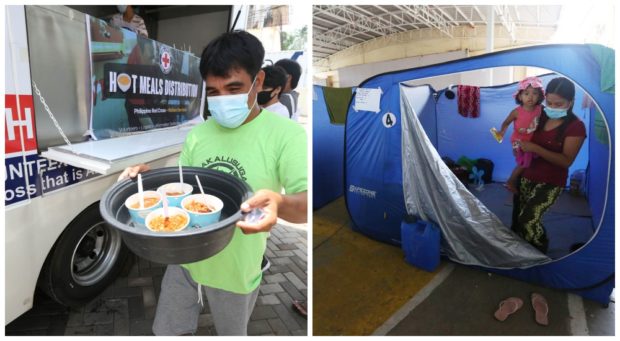Sulfur dioxide from Taal ‘anomalously high’; 2 villages declared ‘no man’s land’

RELIEF Thousands of evacuees cooped up at the Plaza Elena covered court in Agoncillo town, Batangas province, receive bowls of free meals from Philippine Red Cross volunteers as Taal Volcano exhibits “anomalously high” volcanic sulfur dioxide gas emissions on Sunday. —MARIANNE BERMUDEZ
LUCENA CITY, Quezon, Philippines — Two villages in Agoncillo town in Batangas province were declared “no man’s land” as Taal Volcano remained restive four days after its phreatomagmatic eruption on Thursday.
Agoncillo Mayor Daniel Reyes said residents in the villages of Banyaga and Bilibinwang, both within the 7-kilometer danger zone of the volcano, had been evacuated upon the orders of the Department of the Interior and Local Government and the Office of Civil Defense on Saturday.
Reyes said the two barangays had a combined population of more than 6,000 residents, or 1,300 families.
“There should be no one left in the two barangays,” he said in a video message posted on Facebook on Saturday afternoon.
The Philippine Institute of Volcanology and Seismology (Phivolcs) raised alert level 3 over Taal Volcano following Thursday’s eruption.
Article continues after this advertisementHazardous eruption
The alert means magma is near or at the volcano’s surface, with its activity possibly leading to “hazardous eruption in weeks,” Phivolcs said on its website.
Article continues after this advertisementThe agency’s highest alert level is No. 5, which means “hazardous eruption in progress.”
Reyes said he initially resisted the order for evacuation but relented after considering the safety of residents and Agoncillo’s zero-casualty record when the volcano erupted in January last year.
The mayor said he was coordinating with the municipal government of Balayan, the designated evacuation area for residents of Agoncillo.
He said all residents from the two villages would have been transported to that town by Sunday.
But he also pointed out that some residents wanted to be allowed to return to their villages for several hours a day to look after their belongings and attend to their fish cages.
Reyes said this would require approval from the national government agencies concerned.
‘Anytime soon’
Taal Volcano on Sunday had an “anomalously high” volcanic sulfur dioxide gas emission, accompanied by strong volcanic quakes, Phivolcs said as it warned that the volcano might erupt anew “anytime soon.”
Government volcanologists said sulfur dioxide gas emissions reached an average of 22,628 tons per day on Sunday, the highest ever recorded in Taal, they said.
Phivolcs monitoring equipment also recorded 26 strong to very shallow low-frequency volcanic quakes beneath the eastern sector of Taal Volcano Island, locally known as “pulo.”
Some of these quakes, which were associated with the degassing of magma, were reportedly accompanied by rumbling and were felt by fish cage caretakers off the northeastern shorelines of the volcano island, volcanologists said.
“These observation parameters may indicate that an eruption similar to the July 1, 2021, event may occur anytime soon,” Phivolcs said in its advisory on Sunday afternoon.
Science Undersecretary Renato Solidum Jr., the Phivolcs officer in charge, said these parameters do not yet point to increasing the alert status of Taal to alert level 4.
“Assessment is based on available data as manifested by Taal, but we will continuously evaluate further monitoring data,” he told the Inquirer.On July 1, the interaction of new, rising magma and the water in the main crater lake resulted in an explosion that lasted some five minutes.
Evacuation, health checks
Following the eruption, Phivolcs quickly raised the alert status of Taal to alert level 3, signifying magmatic unrest, and recommended the evacuation of residents from high-risk barangays in Agoncillo and Laurel towns in Batangas province.
Following Sunday’s observations, Phivolcs strongly recommended that residents on Taal Volcano Island and in the barangays of Bilibinwang and Banyaga in Agoncillo, and Boso-boso, Gulod and eastern Bugaan East in Laurel, remain evacuated due to possible pyroclastic density flows, or hot, fast-moving clouds of ash, gas and rock debris, and volcanic tsunami that could follow stronger eruptions.
“Communities around Taal Lake shores are advised to remain vigilant, take precautionary measures against possible airborne ash and vog, and calmly prepare for possible evacuation should unrest intensify,” Phivolcs said.
Government volcanologists also advised local governments to conduct health checks on communities affected by the vog, or volcanic smog, and assess the impact of sulfur dioxide emissions on the residents and evacuate them, if necessary.